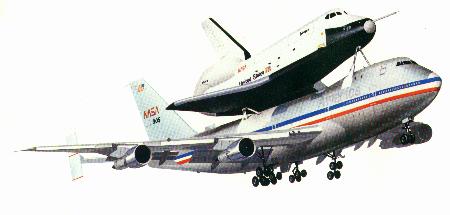Enterprise Class Space Transportation System (STS)

Enterprise class space shuttle in launch configuration with external tanks and solid rocket booster
Image scanned from Quest for Space by C. Bongiorno
Aside from the Russian Soyuz series of space capsules, the American Enterprise class space transportation system, or space shuttle, was one of the most successful lines of space vehicles in the late 20th century. Even after the advent of interplanetary ships such as the DY-100 class, the space shuttles were still used to ferry people and supplies up to the various orbiting space stations. Just as the Apollo-Soyuz mission of 1975 had heralded a new age of peace on Earth, the space shuttle also had its own time of detente in the 1990's when it made several trips to the Russian Mir space station.

External schematics of the Enterprise class space shuttle in both launch and landing configurations
Image scanned from Quest for Space by C. Bongiorno
The greatest innovation that the space shuttle proved was that it was the first reusable space vehicle in the history of Earth spaceflight. It's launch configuration consisted of the shuttle sitting on top of a large fuel tank which supplied liquid hydrogen and liquid oxygen to the shuttles main engines. Attached to the sides of this tank were a pair of solid rocket boosters which gave the shuttle the necessary launch force to lift very massive payloads into space. It was this feature that served the space shuttle best in the early days of Space Station Freedom. The shuttle itself was basically a space-capable airplane, designed to make an unpowered descent. As most pilots noted, the space shuttle was said to have had the aerodynamic characteristics of a brick. But, there were never any major problems while landing a space shuttle.
The space shuttle was most noted for its use as a scientific platform, as well as its cargo hauling capabilities. It was in the cargo bay of the space shuttle that numerous Spacelab modules were launched to perform experiments int he microgravity environment of Earth orbit. Many biological and physical experiments were performed in this lab in order that man can get a better understanding of the place which eventually would become his second home.
The following space shuttles were constructed by the agency which was then called the National Aeronautical Space Administration (NASA):
Enterprise (OV-101): Used as a test vehicle for landing and breaking maneuvers, but never sent into space. Named after a World War II aircraft carrier

Space Shuttle Enterprise riding "piggy back" on a modified Boeing 747
Image scanned from Quest for Space by C. Bongiorno
Columbia (OV-102): Named after an American sailing warship of the 1790's which became the first American ship to circumnavigate the Earth. First space shuttle which actually flew in space.
Challenger (OV-99): Named after an American research vessel of the 1870's. Exploded just after launch on January 28, 1996 as a result of a faulty O-ring in the solid rocket booster. Worst tragedy to this point in the history of manned space flight. The 7 man crew that died on Challenger were commander Richard Scobee, pilot Michael Smith, mission specialists Judith Resnik, Ronald McNair, and Ellison Onizuka, payload specialist Gregory Jarvis, and Christa McCauliffe. Christa McCauliffe was not an astronaut, but a teacher who was chosen from 11,000 applicants for a program to put a teacher into space. This accident caused the United States to stay out of space for two years during which a Presidential Committee investigated the accident and possible ways to avoid any future ones. This committee included such notable historic figures as Brigadier General (ret.) Charles Yeager, who had been the first Terran to (deleberately) break the sound barrier, Neil Armstrong, and physics professor Richard Feynman.
Discovery (OV-103): Named after Captain James Cooks' second ship which explored the South Pacific region of Earth, discovering the island of Hawaii.
Atlantis (OV-104): Named after a research vessel assigned to the Woods Hole Oceanographic Institute
Endeavour (OV-105): Named after Captain Cooks' first research vessel of the 18th century. Built as a replacement for Challenger
Specifications:
Length: 37 m
Wingspan: 24 m
Mass (Empty): 68,000 kg
Payload bay: 18.3 m X 4.6 m diameter
Crew: Up to 7 (Commander, Pilot, Mission Specialist, 1-5 Payload Specialists)
Payload Mass: 29,500 kg
- Propulsion:
- 3 LH2/LO2 main engines
- 2 LH2/LO2 orbital maneuvering system (OMS) thrusters
- Chemical RCS thrusters
Click here to return to the index page.



